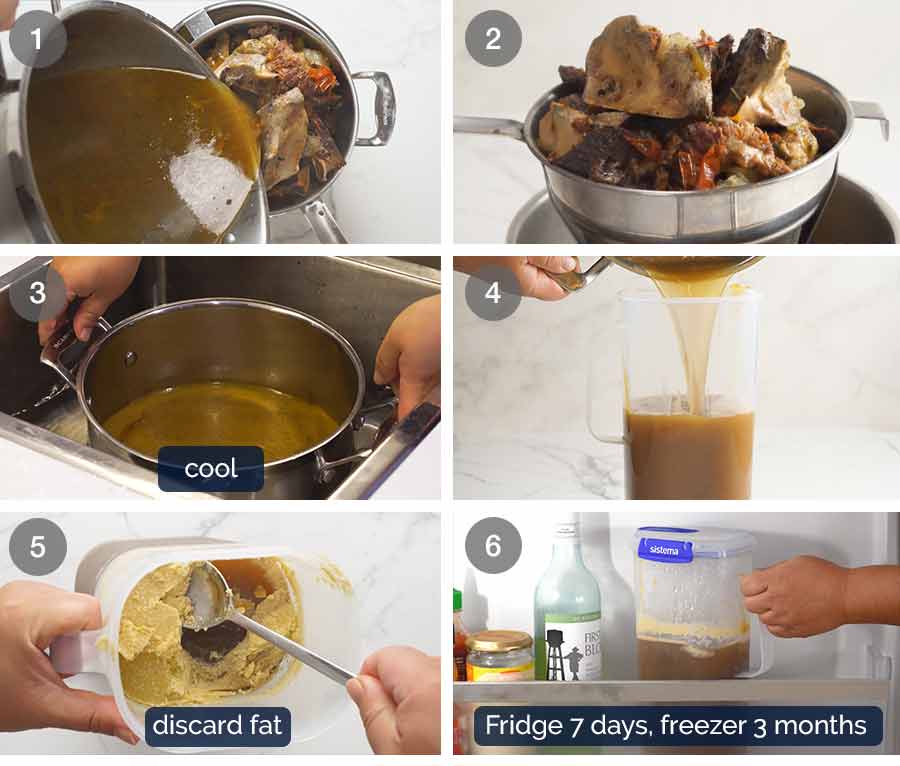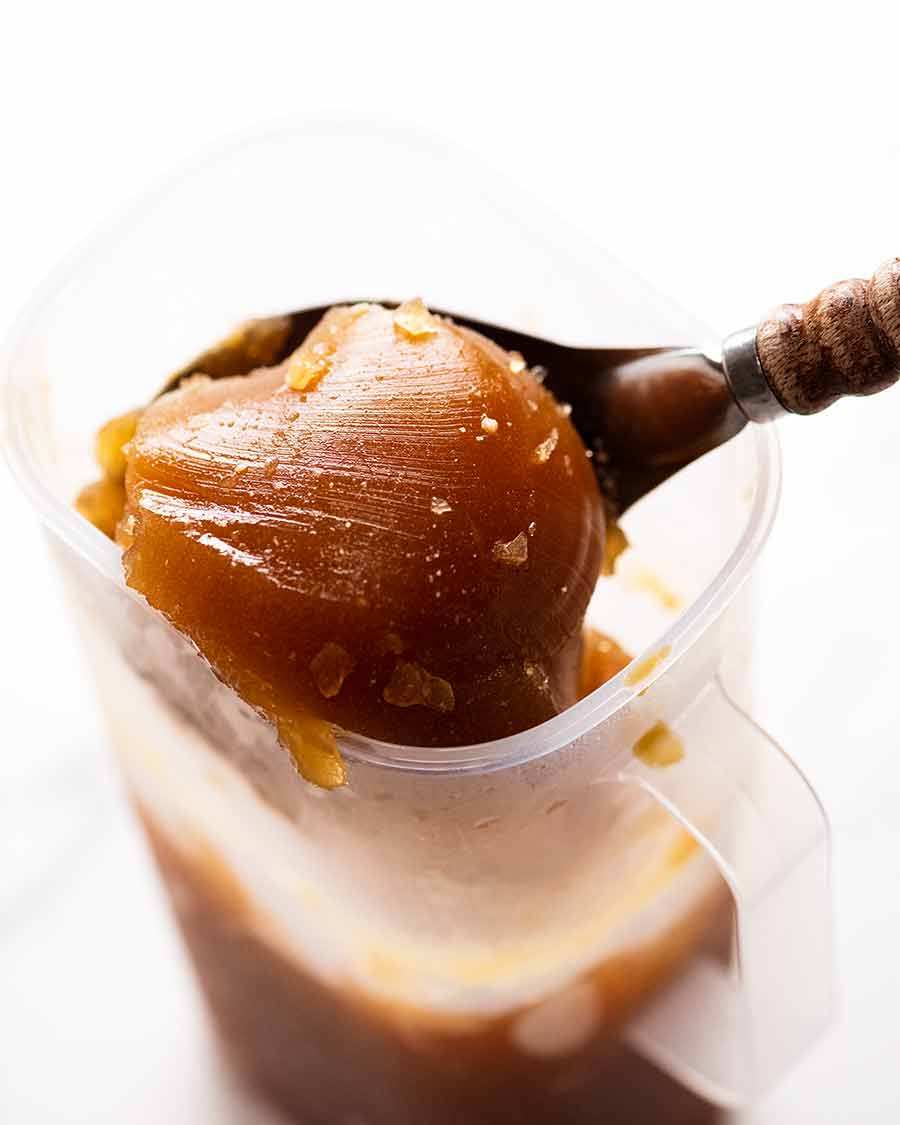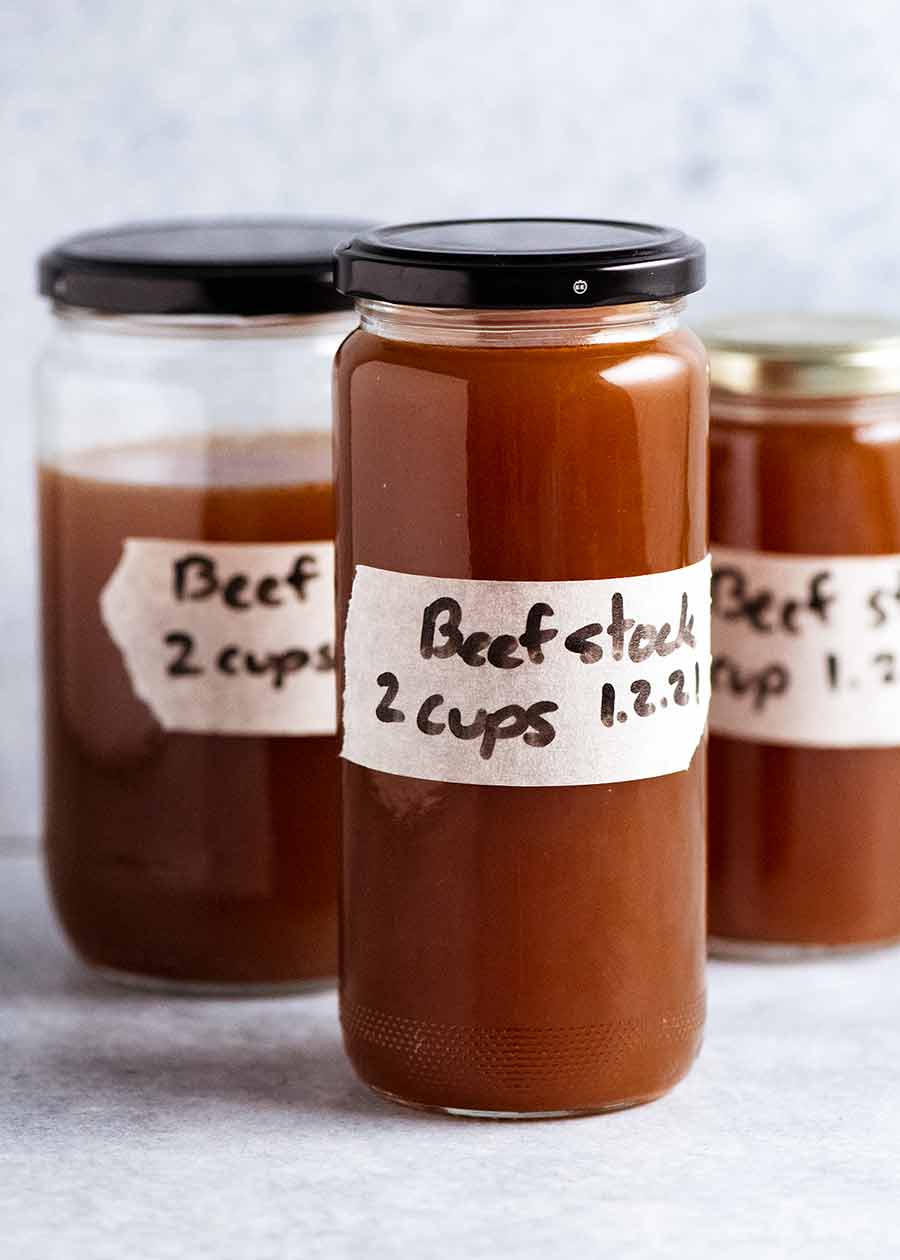This is a classical French-style recipe for homemade beef stock. It’s much better than store-bought stock and one of the main things that sets restaurant cooking apart from home cooking.
Let me say from the outset: homemade beef stock requires effort. It takes time—at least four hours, but ten hours is better—because you have to throw away a lot of hot bones and clean up the big pots and pans.
Beef stock also known as beef broth, is a savory liquid that forms the basis for many soups stews, gravies, and sauces. It’s made by simmering beef bones and meat in water with vegetables, herbs, and spices. The long cooking time extracts gelatin, collagen, and flavor from the bones, meat, and vegetables, resulting in a rich, aromatic broth.
While beef stock made with bones yields the most body and robust flavor, it’s still possible to make a tasty beef broth without using bones The key is to use meaty beef cuts that are high in connective tissue. When simmered for hours, the connective tissue breaks down into gelatin that provides thickness and body to the broth.
Here is a simple, step-by-step guide on how to make flavorful beef stock without bones:
Ingredients
- 2 pounds beef chuck roast or stew meat, cut into 1-inch cubes
- 1 onion, chopped
- 2 carrots, peeled and sliced
- 2 stalks celery, sliced
- 1 tablespoon tomato paste
- 2 cloves garlic, smashed
- 1 teaspoon black peppercorns
- 1 bay leaf
- 5 sprigs thyme
- 5 sprigs parsley
- 8 cups water, plus more as needed
- Salt and pepper to taste
Instructions
Step 1: Brown the Beef
Heat 1 tablespoon oil in a large stockpot over medium-high heat. Working in batches, add the beef cubes and brown on all sides, about 8 minutes per batch. Transfer the browned beef to a plate and set aside.
Browning the meat adds color and boosts the flavor of the finished stock. Make sure to brown the meat thoroughly without overcrowding the pot.
Step 2: Sauté the Aromatics
Add the onion, carrots, and celery to the pot Reduce heat to medium and cook, stirring occasionally, until the vegetables are softened and lightly browned, about 8 minutes.
Add the tomato paste and cook, stirring constantly, for 2 minutes. This adds sweetness and boosts the savory umami flavor.
Stir in the garlic and cook for 1 minute until fragrant.
Step 3: Simmer the Stock
Return the browned beef and any accumulated juices to the pot. Add the peppercorns, bay leaf, thyme, parsley, and 8 cups water. Bring to a boil over high heat.
Once boiling, reduce heat to low. Simmer uncovered, skimming any foam or impurities that rise to the surface, for 3 hours. Add more water if the liquid reduces too much.
Simmering for several hours allows the meat to break down and impart a rich, beefy flavor. Make sure the liquid barely simmers to avoid emulsifying the fat into the broth.
Step 4: Strain and Season the Stock
Once done, remove from heat and strain through a fine mesh sieve. Press on the solids to extract as much liquid as possible.
Season with salt and pepper to taste. For a clearer broth, strain a second time through a coffee filter or cheesecloth.
Let cool to room temperature before refrigerating or freezing. Remove the layer of fat before using or storing long-term.
The strained solids can be used to make a meat ragu or stew.
Tips for the Best Homemade Beef Stock
-
Use meaty cuts like chuck roast, brisket, or short ribs rather than lean steak. The extra collagen and connective tissue is what gives the stock body and flavor.
-
Roast the bones and meat before simmering to enhance the deep, roasted flavors.
-
Add acids like tomato paste, red wine, or a splash of vinegar to help extract collagen and add complexity.
-
Skim regularly to produce a crystal clear broth. Impurities can make the stock bitter and cloudy.
-
Simmer as low as possible to prevent emulsifying the fat, which results in a greasy mouthfeel.
-
Don’t boil the stock or overreduce it, as this can cause the broth to be cloudy.
-
Use a combination of bones and meat. The bones provide body while the meat offers beefy flavor.
-
Add herbs, spices, and vegetables only during the last hour to prevent bitterness.
-
Let the stock cool before straining so the fat separates and can be easily skimmed off.
Uses for Beef Stock
Homemade beef stock is versatile and can be used to make:
-
Hearty soups like beef stew, minestrone, French onion soup
-
Beef gravy and pan sauces for roast beef or steak
-
Risotto, pilafs, and other rice dishes
-
Braises and pot roasts to amplify the meaty flavor
-
Reduced into an intense demi-glace sauce
-
Deglazing the fond after searing beef for extra savoriness
-
Cooking beans, lentils, and grains for added richness
-
Flavoring meatloaf, chili, beef stroganoff, or casseroles
Storing and Freezing Beef Stock
-
Beef stock will keep for up to 5 days refrigerated and up to 6 months frozen.
-
Let cool completely before transferring to airtight containers. Leave at least 1 inch of headspace to allow for expansion.
-
Freeze stock in useful portions like ice cube trays or muffin tins. Pop out and store frozen cubes in zip top bags.
-
Always label containers with the date and contents before freezing.
-
Thaw frozen stock overnight in the fridge before using. Avoid thawing at room temperature.
-
Boil thawed or refrigerated stock before use to kill any bacteria. Bring to a simmer then use immediately.
-
If fat has congealed on the surface, skim it off before using or freeze stock in portions without the fat layer.
With this easy step-by-step guide, you can make delicious, homemade beef stock without bones right in your own kitchen. Browning the meat and simmering it slowly with vegetables, herbs, and spices extracts maximum flavor and body. Use beef chuck roast or other collagen-rich cuts for the most robust broth. Follow the tips above for the clearest, most savory homemade beef stock to use in soups, stews, and sauces all season long.

Straining, storage and using
Once the stock has reduced, it’s a matter of straining, discarding excess fat then storing for use!

- Strain: Take the bones out of the stock and pour it through a fine-mesh colander or strainer into a large bowl or clean pot.
- Yield: ~ 1. 3 – 1. 6 liters or quarts: Leave the vegetables in the strainer for a few minutes to get as much liquid out as you can. You should have around 1. 5 litres / quarts of liquid. After getting rid of the extra fat (step 3) there should be about 1 25 litres / quarts of stock;.
- Put the pot in a sink full of cold water with the lid off to cool it down quickly. As it heats up, change the water about every 20 minutes. It should take about 1 hour and fifteen minutes for it to cool down to room temperature, which is about 21°C/70°F. To stop bacteria from growing (they like warm places!) it needs to cool quickly, so we can put it in the fridge as soon as possible. Do not put a big pot of hot stock in the fridge. If you do, the temperature inside the fridge will rise a lot, which is not good.
- Put in the fridge—Transfer to a good storage container—I use a jug—and then put in the fridge;
- Get rid of the fat on top. Once it has been in the fridge for a while, the fat on top will solidify into a white mass. Carefully scrape it off with a big, flat spoon and throw it away. This is beef stock after the fat has been taken out and it has been chilled. It solidifies into a jelly because of the gelatin. Gelatin is what gives the stock that rich, high-end restaurant taste. Because it doesn’t have much gelatin, store-bought stock is always thick.

- There you have it! Your stock is now ready to be used and will keep in the fridge for 7 days (I’ve been told 10 days is fine, but I say up to 7 just to be safe). Else, it can freeze for up to 3 months.
I like to store stock in 1- or 2-cup portions, labelled, in the freezer.

How to use homemade beef stock
You can either heat up homemade beef stock in the microwave or on the stove to turn it back into a liquid that you can measure out. It melts very quickly – literally in a minute or two.
It can be added straight into dishes in cold jelly form too. Since it’s harder to measure out jelly, it’s just a matter of whether I need to measure it or not.

Classic and Essential Beef Stock | Chef Jean-Pierre
FAQ
How to make stock without bones?
Do you need bones for stock?
Can you make beef broth without bones?
How to make beef broth without bones. This light, fragrant, savory, meaty homemade beef broth is ready in 2 hours either on the stove or in a crock pot – perfect for use within soups and stews, for cooking grains, and more! When it comes to homemade vs. store-bought, I’ll admit some recipes simply aren’t worth the time and effort.
What alternatives to bone broth can a vegetarian take?
There is no major bone broth benefit that needs to be replaced. Vegetable broths will have more vitamins and minerals than bone broth, as well as being tastier.
Should I use homemade beef stock?
Use homemade beef stock for any recipe that calls for beef stock or beef broth. Your finished dish will be multiple times better than any version made using store bought, with a far richer, deeper flavour and none of that undesirable artificial edge that store bought beef stock has.
How do you make a good beef stock?
The key ingredient to make a really good beef stock is meaty bones. No meat, no flavour! You need 2 1/2 kg / 5 lb of beef bones to make 1 1/4 – 1.5 litres / quarts of stock (5 – 6 cups). In addition to bones, we also want aromatics which add character, deepen the flavour, add a touch of sweetness and also provide some colour. Here’s what I use:
